Menus
- Between heaven and hell
- Conclusion
- KTM 990 Super Duke
- Triumph Speed Triple
- MOTORCYCLE measurements
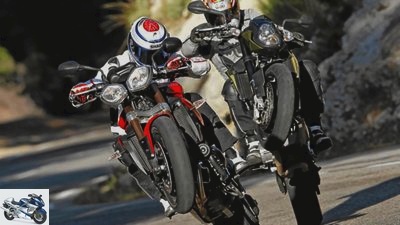
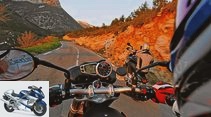
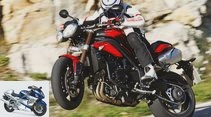
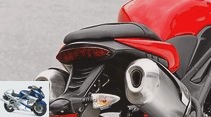
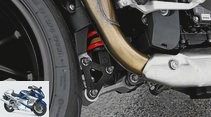
17th photos
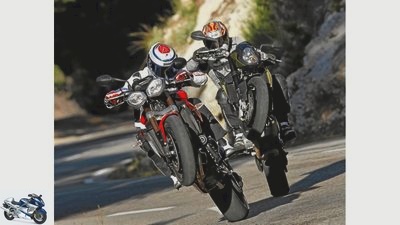
1/17
Both bikes are full of power and emotions and can really sweep the rider away, but which one can impress more, the KMT 990 Super Duke or the Triumph Speed Triple.
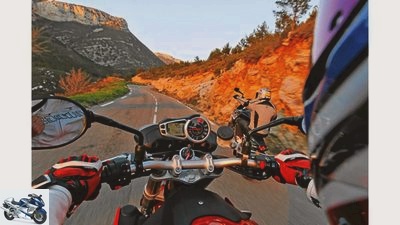
2/17
The Triumph Speed Triple makes things incredibly difficult for the KTM Super Duke, as it hardly has any real points of criticism.
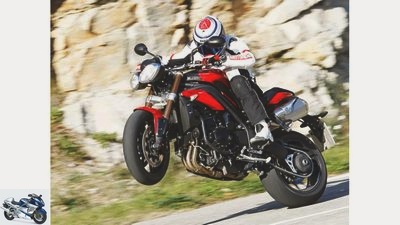
3/17
The Triumph Speed Triple offers top performance at low prices.
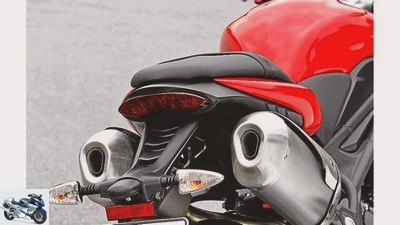
4/17
With the Speedy, the short stub tail leaves little space for the pillion passenger.
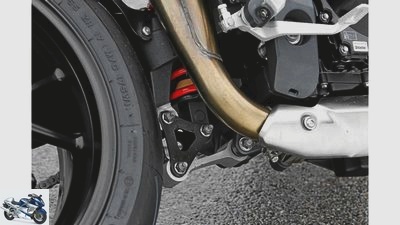
5/17
The redesigned rear wheel lever and the shock absorber are now much more valuable than on the previous model.
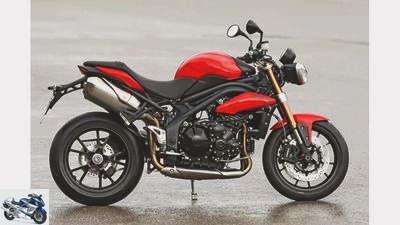
6/17
The new Speedy looks like the old one, but except for the engine everything is really new. Suspension and handling are noticeably improved.
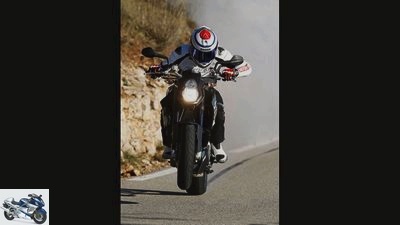
7/17
The KTM 990 Super Duke remains an extremist for the attack department, but it is a little difficult in everyday life.
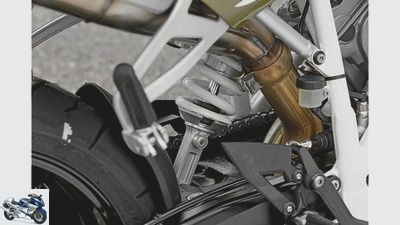
8/17
The WP shock absorber is mounted directly on the swing arm without any lever.
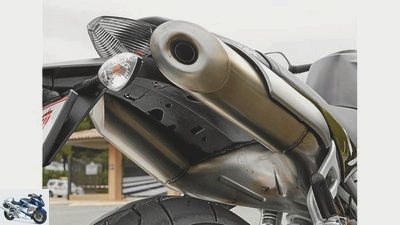
9/17
Both have high, double silencers, with the KTM they are connected over a large area.

10/17
The Super Duke makes no secret of its character: an angular, poisonous iron with a rough charm.
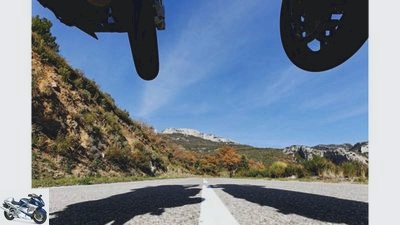
11/17
The front wheels just don’t want to stay on the ground on the Triumph and the KTM.
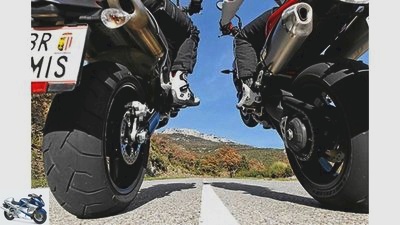
12/17
It’s really close to the point here: When it comes to wheelie suitability, the two test candidates don’t give each other anything.
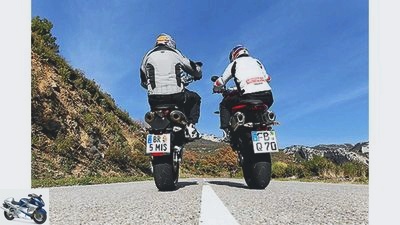
13/17
And they continue to rise.
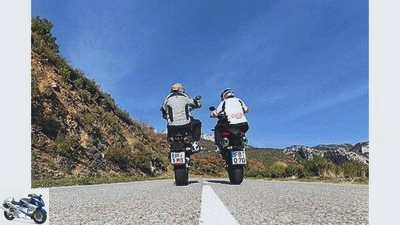
14/17
And further.
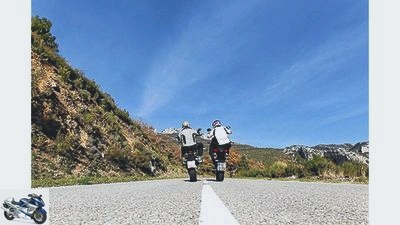
15/17
And on, to infinity.
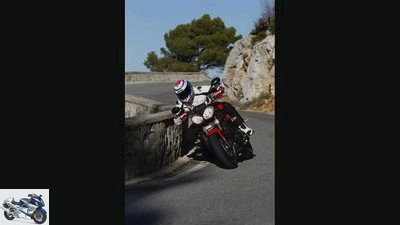
16/17
The Triumph Speed Triple cuts corners really well.
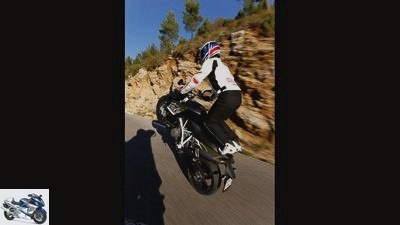
17/17
The KTM 990 Super Duke can also be used to fax properly.
Comparison test: Triumph Speed Triple and KTM Super Duke
Between heaven and hell
No, it really doesn’t work, the front wheels don’t want to stay on the ground. Because the little devil keeps whispering in your ear: gas! Speed Triple and Super Duke – two machines for sport, play, excitement.
Between heaven and hell, between fun and regret, between emotion and reason, the motorcyclist is always somehow found. At least when you let the horses gallop when the front wheel loses contact with the ground. On the one hand there is the eruptive power, the intoxication of the dynamism, on the other hand a bad conscience plagues you: the traffic, the environment, the law enforcement officers.
A.But can wheelie really be a sin? We drive machines with 130 horsepower, so the temporary loss of ground contact at the front can only be avoided with extreme body control. So we let the good Lord be a good man, lift the front wheels and let the rear wheels smoke.
Buy complete article
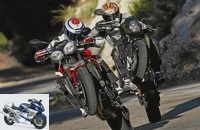
Comparison test: Triumph Speed Triple and KTM Super Duke
Between heaven and hell
990 Super Duke nor Triumph Speed Triple requires a special level of vehicle control. Pure, honest material without plastic casing, crisp iron for hearty driving fun. Machines that shoot their crew through the wind without being filtered. With a lot of fire in the engines, packed in a solid framework.
The Triumph is entering the 2011 model year with a freshly contoured design and sharpened chassis, while KTM last launched the Super Duke in 2007 and reduced the price significantly for 2011. The mother of all street fighters has been around since 1994, the Super Duke only since 2005. They are classics of their genre in equal measure, but are fundamentally different at heart.
What separates them from one another can primarily be reduced to their drive concept. In a nutshell: One pot makes the big difference, the 50 cm³ difference in displacement is certainly not important. On the one hand we have the hoarse, growling three-cylinder from Hinckley, on the other hand the heartily pounding V-Zwo from Mattighofen. Two engines that in a certain way embody the special company philosophy, namely here the somewhat finer thread from the island, there the tough leather from the Alpine region.
The Triumph Speed Triple offers top performance at low prices.
When it comes to pure power, the pressure at the tip, the treble is clearly ahead. On the test stand protocol anyway, especially since the test machine with measured 137 PS stands well in the feed. The triple also paints a beautiful, even slope on paper, no humps, no craters. Therefore, you can actually save yourself a torque curve, a simple number is enough: the Triple easily shakes a full 100 Nm out of its sleeve, virtually independent of the speed, always and everywhere – at least from 3500 tours.
With 121 hp, the Super Duke driver doesn’t have to beg for a doping injection, even though more than 15 ponies are missing to triumph. A shorter gear ratio partially compensates for the shortcoming, so that in the middle speed range there is even a bit more thrust on the rear wheel. The KTM performance curve also strives directly to the summit without significant deviations, but forms a broad plateau at the very top. And the center-weighted power curve gives the torque curve the shape of a bull’s hump. At its zenith, the KTM only crosses the 100 Nm limit very briefly once.
So much for the theory, for the full load curves determined on the roller, which show the first tendencies. Real life is different, more exciting, more explosive, more tingly. It’s about the character of an engine, the interaction of the drive with the rest of the machine. For example, what the existing PS actually have to do, namely move.
And that is almost 20 kilograms less mass at the KTM. As a result, the two opponents are on the same level in terms of power-to-weight ratio: 1.63 kg / hp for the Triumph versus 1.67 kg / hp for the KTM. In connection with the shorter gear ratio, this explains why it can keep up well with the more powerful Triumph in the sprint from a standing start. When it comes to pulling through, the Triumph sets itself apart a little with its higher torque. Especially at higher speeds, when sheer power is required, air resistance gradually gains the upper hand and the mass takes a back seat.
Speaking of top speed: KTM has always homologated a relatively meager 220 km / h as the top speed for the Super Duke. MOTORRAD has measured it, 235 manages it easily, only then does the rev limiter catch it.
The KTM 990 Super Duke remains an extremist for the attack department, but it is a little difficult in everyday life.
It also strikes the Speedy, but only at a speed of 248. But these are more academic values. Back to the character: The two engines are further apart than all diagrams and measured values can convey. On the one hand there is the three-cylinder, which acts smoothly anytime and anywhere, and with its growling sound, predictable power input and smooth thrust from the bottom exudes anything but boredom. An engine that is completely problem-free in everyday life, with which you can travel comfortably across the country, fetch bread in the morning or enjoy a longer journey. One with manners that vibrates little and always works perfectly. But at some point, even with the three-cylinder, there is no more fun. Whenever it is most beautiful, the limiter puts an abrupt end to the hustle and bustle. This comes as a surprise at first, but it’s all a matter of getting used to. The programmable shift light is a helpful accessory for those switching to avoid unpleasant stuttering in the limiter.
Diametrically opposed to this Urglish drive system is the rough character of the Super Duke drive, which defies all attempts at cultivation. A pithy roaring motor that also vibrates roughly at the top, which acts rather unwillingly and not particularly muscularly in the lower area, sometimes jerks and buckes, actually constantly begs for gas and speed. If this pleading is answered, the fascination with the force of a roaring V-Two grows with each turn. He’s hammering the revs out so it’s a real pleasure. It’s nice that, contrary to the trend, KTM has so far left it with the round liter, more displacement would probably be counterproductive.
Actually a wrong world: A three-cylinder, which lives more from torque and a powerful center, suddenly hits the bolt at the top, while the two-cylinder below works cautiously, but then almost does not want to stop turning. Whether the fine, even thrust of the three-cylinder or a hearty kick of the twin, both Nakeds are machines for people with the highest demands on driving dynamics. Just roll around: Sure, it works, but that’s not it. KTM in particular hates slow. This is not the kind of thing you want to torment yourself with to work in a traffic jam in the morning. The great duke needs great freedom. namely space and exercise. So the open country instead of the narrowness of the big city. And not just because of the engine, the whole concept goes in that direction.
The Triumph Speed Triple makes things incredibly difficult for the KTM Super Duke, as it hardly has any real points of criticism.
The ideal environment can be sketched out quite easily: Magnificent weather always helps, plus winding country roads that should be perfectly flat, if you please. Then the Super Duke shines with razor-sharp handling, then it can show off its low weight and the exciting acceleration of the two-cylinder.
There are reasons why she reacts uncomfortably to bumpy terrain. The somewhat insensitive rear wheel suspension is involved in this, including the chassis geometry, a little perhaps the abrupt throttle response, and probably also the tires. You have to counteract, correct, steer, there is a lack of steering precision and neutrality.
The KTM doesn’t give you anything, you have to work to have fun. Whoever gets involved, takes the bull by the horns, will be rewarded with the greatest pleasure. On the other hand, the Speed Triple is hand-tame, especially since the chassis is extremely cooperative in addition to the easy-care drive. The suspension absorbs the roughest road-building mess, the steering remains neutrally on course in every lean angle. The part is easy to drive, only with quick changes of direction the Speedy cannot hide the higher weight.
So it fits into the picture that only Triumph offers an optional anti-lock device for the brakes. ABS is for wimps, the die-hard KTM driver would argue. But he is quickly taught better if he completely collapses the Triumph on dubious ground. The new Nissin ABS of the Speedy regulates sensitively, the rear wheel sticks to the ground. And the mixture of Nissin and Brembo parts is also convincing outside the control range, i.e. in normal everyday life, with its filigree controllability and clear feedback. Until KTM is ready, the Super Duke driver can enjoy the finest ABS-free Brembos. Great effect, reliable steadfastness. And above all, the highest level of transparency, which in a certain way also represents a type of ABS, albeit with the human weakness.
So both promise heaven on earth. But when the front wheels roll on the ground and you turn to the nasty things of everyday life, then the more harmonious Speed Triple convinces. But one could certainly fall for the charm of pure sin, the diabolical Super Duke.
Conclusion
It’s really close to the point here: When it comes to wheelie suitability, the two test candidates don’t give each other anything.
1st place: Triumph Speed Triple
Clear victory on points: apart from the pillion rider, there are hardly any real criticisms of the new Speedy.
2nd place: KTM 990 Super Duke
The tough iron: The Super Duke is and remains an extremist for the attack department, in everyday life she has to give up.
MOTORCYCLE scoring
Category engine:
Both offer top performance, and nobody has to complain about a lack of performance. The Triumph works out its lead in this chapter thanks to the smoother running three-cylinder engine, the KTM two-cylinder runs more jerkily due to its design. The gear changes on both test machines are a bit bony, which applies more to the Triumph than to the more precisely shifted KTM.
Winner engine: triumph
Category chassis:
Sporty suspension components at the highest level ensure good driving characteristics. The lighter KTM is a tad more manageable in alternating bends, but the Triumph can also be folded down with little effort. However, the Super Duke steers itself a little stubbornly in an inclined position, especially on undulating ground. Small compromises in terms of comfort are a result of the strict basic attitude.
Chassis winner: KTM / Triumph
Category everyday life:
Both machines are a case for soloists, the passenger has to fold up like on a super sports car. The Speed Triple collects decisive points in terms of equipment, it offers better fuel control, many display functions and the programmable shift light. The KTM counteracts with a simple visual check of the oil level, with the Triumph you have to unscrew the dipstick.
Winner everyday: triumph
Category Security:
When it comes to ABS, the super duke (still) has to fit, only Triumph can offer that as a chargeable extra. Otherwise the fantastic KTM brake has reference qualities. The Speedy decelerates hardly worse, whether with or without ABS intervention.
Winner safety: triumph
Category costs:
Consumption is not exactly a glory for either. The inspection costs are also too high at KTM.
Winner Cost: Triumph
| Max points | KTM | triumph | Overall rating | 1000 | 628 | 675 |
| placement | 2. | 1. | Price-performance note | Top grade 1.0 | 2.2 | 1.8 |
Price-performance winner: Triumph
Significantly more points, a favorable price despite ABS, that results in an excellent grade.
KTM 990 Super Duke
The Super Duke makes no secret of its character: an angular, poisonous iron with a rough charm.
engine:
Water-cooled two-cylinder four-stroke 75-degree V-engine, two overhead, chain-driven camshafts, four valves per cylinder, bucket tappets, dry sump lubrication, injection, Ø 48 mm, regulated catalytic converter, 450 W alternator, 12 V / 11 Ah battery, hydraulic actuated multi-disc oil bath clutch, six-speed gearbox, O-ring chain, secondary ratio 38:16.
Bore x stroke 101.0 x 62.4 mm
Displacement 1000 cc
Compression ratio 11.5: 1
rated capacity 88.0 kW (120 PS) at 9000 rpm
Max. Torque 100 Nm at 7000 rpm
landing gear:
Steel tubular frame, upside-down fork, Ø 48 mm, adjustable spring base, rebound and compression damping, two-arm swing arm made of aluminum, central spring strut, directly hinged, adjustable spring base, rebound and compression damping, double disc brake at the front, Ø 320 mm, four-piston fixed calipers, Rear disc brake, Ø 240 mm, single-piston floating caliper.
Cast aluminum wheels 3.50 x 17; 5.50 x 17
Tires 120/70 ZR 17; 180/55 ZR 17
Tires in the test Pirelli Diablo Corsa III
Mass and weight:
Wheelbase 1450 mm, steering head angle 66.1 degrees, caster 101 mm, suspension travel f / r 135/160 mm, seat height * 845 mm, weight with a full tank * 203 kg, load * 177 kg, tank capacity / reserve 18.5 / 2.5 liters.
guarantee two years
Service intervals 7500 km
Colours Black / green, black / orange
price 10,995 euros
Additional costs around 250 euros
* MOTORCYCLE measurements
Triumph Speed Triple
The new Speedy looks like the old one, but except for the engine everything is really new. Suspension and handling are noticeably improved.
engine:
Water-cooled three-cylinder four-stroke in-line engine, a balance shaft, two overhead, chain-driven camshafts, four valves per cylinder, bucket tappets, wet sump lubrication, injection, Ø 46 mm, regulated catalytic converter with secondary air system 456 W, battery 12 V / 12 Ah, mechanically operated multi-plate oil bath clutch , Six-speed gearbox, x-ring chain, secondary ratio 43:18.
Bore x stroke 79.0 x 71.4 mm
Displacement 1050 cc
Compression ratio 12.0: 1
rated capacity 99.0 kW (135 hp) at 9400 rpm
Max. Torque 111 Nm at 7750 rpm
landing gear:
Bridge frame made of aluminum, upside-down fork, Ø 43 mm, adjustable spring base, rebound and compression damping, single-sided swing arm made of aluminum, central spring strut with lever system, adjustable spring base, rebound and compression damping, double disc brake at the front, Ø 320 mm, four-piston fixed calipers, disc brake rear, Ø 255 mm, double-piston floating caliper.
Cast aluminum wheels 3.50 x 17; 6.00 x 17
Tires 120/70 ZR 17; 190/55 ZR 17
Tires in the test Metzeler Racetec Interact K3
Mass and weight:
Wheelbase 1435 mm, steering head angle 67.2 degrees, caster 91 mm, spring travel f / r 120/130 mm, seat height * 840 mm, weight with a full tank * 221 kg, payload * 188 kg, tank capacity 17.5 liters.
guarantee two years
Service intervals 10000 km
Colours Black White Red
price 11,245 euros
Price test motorcycle** 11845 euros
Additional costs around 350 euros
* MOTORCYCLE measurements
**Incl. ABS (600 euros)
MOTORCYCLE measurements
archive
The performance diagram of the two bikes.
Exemplary curves without dips conjure up both engines on the test bench printout. While the Triumph is suddenly cut off by the limiter, the KTM’s curve flattens noticeably before the maximum speed. The three-cylinder, which is only slightly larger in displacement, clearly surpasses the V2 in terms of power and torque. Nevertheless, the 20 kilogram lighter Super Duke is on par in the measured values in many disciplines and only has to give in in the upper speed range.
Maximum speed (manufacturer information):
| Manufacturer | Km / h | KTM | 220 (235 *) |
| triumph | 248 |
acceleration:
| Manufacturer | 0-100 km / h | 0-140 km / h | 0-200 km / h (sec) | KTM | 3.2 | 5.2 | 10.6 |
| triumph | 3.2 | 5.1 | 10.5 |
Draft:
| Manufacturer | 60-100 km / h |
100-140 km / h |
140-180 km / h (sec) | KTM |
3.6 | 3.8 | 4.3 |
| triumph |
3.5 | 3.8 | 4.8 |
Fuel consumption (country road):
| Manufacturer |
Liters / 100 km |
| KTM |
Super 6.2 | triumph |
Super 5.6 |
Theoretical range (country road):
| Manufacturer |
Km |
| KTM |
298 | triumph |
313 |
* MOTORCYCLE measurements
Related articles
-
Comparison test: MV Agusta Brutale, Triumph Street Triple, KTM Super Duke
fact comparison test: MV Agusta Brutale, Triumph Street Triple, KTM Super Duke Three naked bikes in direct comparison There are motorcycles for which …
-
35 pictures 1/35 BMW S 1000 R, Ducati Monster 1200 S, KTM 1290 Super Duke R and Triumph Speed Triple R in comparison …
-
Benelli TnT 1130 Century Racer, KTM 990 Super Duke R, Triumph Speed Triple
Gargolov 40 photos 1/40 2/40 3/40 4/40 5/40 6/40 7/40 8/40 9/40 10/40 11/40 12/40 13/40 14/40 15/40 16/40 17/40 18/40 19/40 20/40 21/40 22/40 23/40 24/40…
-
Triumph Speed Triple S against Suzuki GSX-S 1000 in comparison test
Rivas 19th photos Arturo Rivas 1/19 Image gallery: Triumph Speed Triple vs. Suzuki GSX-S 1000. Arturo Rivas 2/19 The universally popular biker greeting…
-
Ducati Monster 1200 S Triumph Speed Triple R in the test
www.bilski-fotografie.de 35 pictures bilski-fotografie.de 1/35 Ducati Monster 1200 S and Triumph Speed Triple R in the comparison test bilski-fotografie.de 2/35 …
-
Honda CB 1000 R, MV Agusta Brutale 1090 RR ABS and Triumph Speed Triple R in the test
34 photos www. 1/34 The four-cylinder of the MV Agusta Brutale 1090 RR is extremely easy to turn, from which it draws its high…
-
Comparison test: MV Agusta Brutale 675 and Triumph Street Triple
fact 15 pictures fact 1/15 The MV Agusta Brutale 675 attacks the Triumph Street Triple in the middle class sector of naked bikes. fact 2/15 The Street …
-
20 years of Triumph Speed Triple
fact 22nd photos Breutel 1/22 Stuart Wood, 50, Head of Model Planning and Electronics, has been with Triumph for 27 years and is involved in the…
-
Comparison test Aprilia Tuono V4 1100 Factory KTM 1290 Super Duke R 2018
Arturo Rivas 16 pictures Rossen Gargolov 1/16 Anyone who has been able to enjoy this power and magnificence will never forget it. Rossen Gargolov 2/16 …
-
Comparison test: Aprilia SL 750 Shiver, Benelli TnT 899S, Ducati Monster 696, Triumph Street Triple
Gargolov comparison test: Aprilia SL 750 Shiver, Benelli TnT 899S, Ducati Monster 696, Triumph Street Triple Italy – England 3: 1 content from Die …